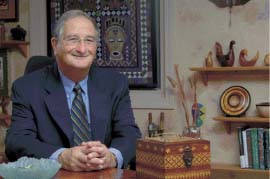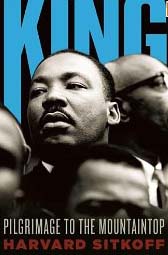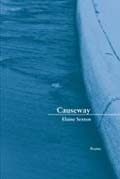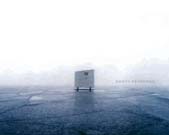|
Previews
Books, music, art, theater, film, and dance
by Anne Downey '95G
|

|
Reviewed in this issue:
King: Pilgrimage to the Mountaintop
,
By Harvard Sitkoff
Overviews:
Elaine Sexton '76
Heather King '77
Scott Peterman '91
In Their Own Words:
Paul Martin '78
Courtney Maxwell '06
Michael Morshed '08
Leah Melber '92
Christopher Fauske '84
Patricia Lynne Grace Cummings '73
Also of Note:
Elizabeth Kirschner '79
Charlie Bevis '75
George C. Daughan '61
M. Ann Jacoby
News from Theatre and Dance alumni:
Mike O'Malley '88, Michael Graziadei '01, Robyn Hurder and Maryann Plunkett '76
King: Pilgrimage to the Mountaintop
By Harvard Sitkoff
Hill and Wang, 2008
See at amazon.com
Remaking a Myth
King was not who we thought he was, argues Harvard Sitkoff
Martin Luther King Jr. is enshrined in America's pantheon of celebrated leaders as an unparalleled orator and organizer who helped right the wrongs of the past. But as Harvard Sitkoff points out in his immensely readable new biography, King: Pilgrimage to the Mountaintop (Hill and Wang, 2008), we know less about King the radical visionary, whose most deeply held beliefs continue to be relevant.

"The King who is trotted out each January is a moderate guy who worked well with presidents to accomplish some decent, long overdue reforms," explains Sitkoff, a UNH professor of history. But most of King's ideas about economics, foreign policy and the exploitation of people around the world were quite radical and very unpopular at the time, he says. "For example, he was vehemently opposed to the Vietnam War and spoke out against it long before it was acceptable to do so. He insisted that racial justice was inextricably linked to economic justice and to international peace. The FBI accused him of being 'the most dangerous Negro in the country.'"
Sitkoff is the author or editor of eight books on civil rights history, but this book, he says, was the easiest to write. "King has had the biggest impact on my life of any public figure. I remember the excitement I felt as a boy reading accounts of the Montgomery bus boycott. As a college student, I went south to march and picket. Nothing exhilarated me more than King shaking my hand at a demonstration in Virginia in 1962." He also recalls standing in the rain in Atlanta as King's casket went by. "This was a book I had to write," he says.

Stikoff's purpose in writing this biography was to write a concise book for the general reader. One of the many moving accounts in the book is the "dark night of the soul" King experienced when thrust into the forefront of the Montgomery bus boycott. The 27-year-old King had been pastor at a local church for just three months when Rosa Parks refused to relinquish her seat; nevertheless, he was asked to lead an umbrella organization to organize the boycott.
King's public position drew death threats, hate mail, jail time and persistent obscene telephone calls that left him exhausted and paralyzed with fear. His faith up until that point had largely been intellectual, according to Sitkoff, who describes a scene where King is sitting alone at his kitchen table and hears an inner voice. "He believed it was Jesus telling him to fight on," writes Sitkoff. "For the first time, God became profoundly real and personal to him."
That experience, and his peace-filled courage in the days to follow, touched millions of people and changed the course of history, Sitkoff says: "Although he was on the stage of public affairs for barely a decade, and never held public office, King shaped more sweeping changes in habits of thought and action than any other figure of his century." ~
| Overviews: |
Causeway: Poems
by Elaine Sexton '76,
New Issues Press, 2008.
See at amazon.com
The poems in Sexton's lovely second collection span her attentive imagination, which embraces the grit of the city as well as the tiny life in the tide; she writes about her "swimming lessons" in "Tidings": "All summer my instruction/eschewed/convention. I learned to submit/my body/to space,/to the cycle of plankton/and progeny, to ferry/myself among others, to commute."
|

|
Redeemed: A Spiritual Misfit Stumbles Toward God, Marginal Sanity, and the Peace That Passes All Understanding
Heather King '77,
Viking 2008.
See at amazon.com
King's second memoir is an unflinchingly honest, funny and profound account of her spiritual journey toward Catholicism and Christ, "the most radical, subversive, never-endingly surprising Savior I can imagine."
|

|
Scott Peterman
by Scott Peterman '91,
Channel Photographs, 2008.
See at amazon.com
The 54 stunning images in Peterman's monograph are either of ice fishing shacks in Maine and New Hampshire or empty landscapes. All are minimalist in form and meditative by nature, and the photos of the structures invite assessment of their vernacular architecture, while transforming them into art objects.
|

|
In Their Own Words
Descriptions of new and recent written work by the authors themselves
Paul Maurice Martin '78
See at amazon.com
Original Faith: What Your Life Is Trying to Tell You, draws much of its inspiration from the New Hampshire landscape and my twenty-three years of working with elementary students, mostly in New Hampshire's public schools. The book takes a unique approach to spirituality by discussing it exclusively in terms of experience, not doctrine. I have a master's in counseling from UNH and a master's from the University of Chicago Divinity School.
Original Faith's experiential, non-doctrinal approach helps to enrich the believer's consciousness of faith and spiritual life while bringing this dimension of experience to the attention of nonbelievers. The book includes practical guidance to help foster transition from an identity based on ego to one based on love and beyond - without oversimplifications or false promises, and with the understanding that genuine self development means becoming increasingly passionate about the good of the wider world.
I'm in my fifteenth year of a progressive disease that by now has me mostly bedridden; I live by what I've written. With a faith known first hand, we find that we are here not to seek meaning, but to help create it.
|
 |
|
Courtney Maxwell '06
See at amazon.com
I recently published a vampire romance novel, Changed Through Blood, with Blue Mustang Press. This is a story of a human named Calista who travels the world to keep her heart away from relationships. But as she wanders the earth, she stumbles across a world that most people don't believe exists: the world of vampires. Not only does she learn that they exist, but she manages to fall in love with one of them. His name is Ayden. Despite the people in his life that attempt to keep them apart, Calista and Ayden are determined to be together. However, as Calista attempts to heal her pain with her love for Ayden, she finds herself in the middle of a war between vampires and humans that has lasted for centuries.
It's funny - when I talk to people about how I wrote this book, they always ask if my major was writing or journalism. It certainly shocks them when I tell them my major was Accounting. But writing is just something that I like to do as a hobby.
This is the first novel I have written. I do plan to write more in the future. The next book to come will be the prequel to Changed Through Blood. The best thing that has come out of all this is the amazing support and excitement that I have received from my friends and family. I hope that writing novels is something I can continue to do for a long time.
|
 |
|
Michael Morshed '08
See at amazon.com
The first book I have published came out in the early winter of '08 - the same season I graduated from UNH. Its title is No Room for Innocence, and it is at times as nasty and the characters as downtrodden as the title suggests. Traditional methods to figuring one's place in life's rat race are not satisfactory in the world these characters endure, and they seek alternatives. They are people in their twenties, and they can be crude, lavish, abrasive, and excessive, but that's how you live when you're that age. You're on the edge of something, and you must act like you are. There's Page, a lost poet whose early success and fame has been followed by an artistic void. Then there's Longwell, a rude, fat, kid that uses verbal muscling to sway the group how he pleases. And finally is Colander, the kindest one.
The main characters are three friends that live in a Bohemian-style section of an unnamed city, on Huntington St., waiting for their lives to change. Page enjoys several women, Longwell preys on the weak, and Colander is sure he's being followed by some suspicious character. They all drink plenty. But when they run up against the local mob scene, they find themselves in over their heads, lost in a world they thought they knew.
|
 |
|
Leah Melber '92
See at amazon.com
My recently published book, Informal Learning and Field Trips, was nearly fifteen years in the making. Intended to support classroom educators and home-school families in making the most of field trips, I took from my experience as a classroom teacher, museum educator and university professor to create a work that was both practical, and based on established theory on how students learn.
With evidence that children remember field trips well into adulthood, I was inspired to create a work that would help educators make all field trip experiences truly special. Though based in the latest research on informal learning, the book is written with the busy educator or parent in mind. Ideas are ready to implement with the necessary assessment support, sample data sheets, and explicit links to national standards provided. Each chapter discusses how field trips can support various curricular areas, from language arts to technology. Vignettes provide the reader with a first-hand account of what the experience would look like, and are taken from my own experiences both in the classroom as well as the exhibition halls of the museum. A variety of helpful websites are provided to further extend highlighted experiences.
Destinations addressed in the book are varied- from a nearby park to a large, rambling zoo- and should meet the needs of educators from urban, suburban, and rural locations alike. Acknowledging that many educators cannot take multiple field trips, the book contains activities to conduct on campus as well as information on how to convince administration or outside funders of the importance of field trips to the classroom curriculum. The work also provides specialized guidance for sharing field trips with English learners as well as students with disabilities.
The importance of field trips and experiences outside the classroom cannot be overemphasized. This work seeks to be just one piece of an overall plan to provide children with quality access to the world beyond the classroom.
|
 |
|
Christopher Fauske '84
See at adinfinitumbooks.com
Cross-Cultural Communications has recently published my translation of the
Norwegian novel, Skipper Worse, by Alexander Lange Kielland, the first full-length version in English. The ISBN is 978-0-89304-222-3 (pbk) or 978-0-89304-110-6 (cloth). The publisher's blurb sums it up nicely: Skipper Worse is a penetrating portrait of emotions and passions in a small coastal Norwegian town, where love and marriage struggle with pride and ambition. One of the most powerful and representative novels of late 19th-century European realism, Skipper Worse reveals why Alexander Lange Kielland belongs in the same company as Charles Dickens, Edith Wharton, and Katherine Mansfield.
|
 |
|
Patricia Lynne Grace Cummings '73
Ellen Emeline (Hardy) Webster (1867-1950): Her Amazing Quilt "Charts," Her Writings, and Her Life
Whenever I mention having written an e-book that is both a biography and an exploration of quilt history, folks ask the same question: "How did you happen to do that?" Every story is complicated. I will shorten this one. I was aware that Ellen Webster's quilt "charts" were given to the New Hampshire Historical Society in 1968. They were unexplored history, in that they had never been photographed in their entirety, nor studied to any degree by a knowledgeable quilt historian.
What are these so-called "charts" and why are they important? Actually, the 162 charts feature more than 200 designs of quilt blocks or whole quilts that simulate actual antique quilts which Ellen Webster saw, primarily in New England. The charts, set on a paperboard, measure 20" x 30" or smaller, and are composed of precisely-cut, glued-on pieces of cloth. Wallpaper, instead of fabric, was used to re-create some of the designs, and other motifs were hand-painted.
As a quilt historian, I knew right away, from the notations that Mrs. Webster had added to the charts in pencil, that there were connections to other quilt historians and designers, and their work in the late 1920s and 1930s. Quickly, I found myself obsessed with finding out more about the charts, but also immersed in the details of Ellen's life. For months, I tracked down one fact after the other, as steadily as a bloodhound on a trail. There was so much to document, learn, and uncover!
In reading her obituary, and in examining many other documents, including her birth and marriage records at the New Hampshire Bureau of Vital Records, it became abundantly clear that the name of the person who made the charts was Ellen Emeline (Hardy) Webster. From 1997-2007, one other writer misreported Mrs. Webster's first name. That created an unfortunate situation because the misinformation has been repeated in other print venues and on film. Correcting the historical record became a partial reason for doing this project.
Once Ellen's name was firmly verified, it was easy to trace her family tree all the way back to England. Mrs. Webster's writings about her own ancestors are included in a book named Hardy and Hardie, Past and Present; I found anecdotes there that are at once amusing, charming, and instructive of nineteenth century ways. Other information just flowed. I visited Hebron, her home town, as well as the mill town of Franklin, where she lived after her marriage to Clarendon Webster, D.D.S. He, too, was misnamed in print, and was called "Clarence." In actuality, he preferred to be called "Carl."
At every turn in this project, an exciting revelation popped up. Over the course of about eight months, I contacted people all over the country. One lead led to another, and the final result was the chance to meet Ellen's living relatives. Graciously, we were allowed to study and photograph two nineteenth century, family quilts, one of them a crazy quilt made by Ellen's mother. We were given access to Ellen's diaries, letters, and her Lecture Brochure. In fact, I have collected all of her published and unpublished writings, insofar as they are known to exist. A few manuscripts that were mentioned as being in progress seem to be missing, perhaps lost to the auction market.
Mrs. Webster had a fascination with the natural world and was relentless in her quest to learn more about the luminous moss that grew underneath her friend's barn in Groton, New Hampshire. She went to great lengths to access a scholarly paper, written in Japan. She was almost 82 when her own paper on the subject was published. It is too bad that Ellen was not still here seven years later when an international entourage of bryologists came to New Hampshire to see the moss. Her friend, Mary Lamprey, was still living and cordially hosted the group. Photos of the moss appear in the book.
To describe who Mrs. Webster was, and what she did in life, would ... take a book. In summary, Ellen demonstrated a desire to teach from her earliest days. She was an organist who was very active in her church. She was a mountain climber who loved Mount Moosilaukee. She was an adoptive mother who raised her sister's daughter, providing her with an outstanding education. Ellen was a learned person who loved poetry and history, and who once taught mathematics. She was granted both a bachelor's degree and a master's degree from Boston University, at a time when advanced degrees were not common for women. She taught Bible Studies and other subjects at Wheaton College in Norton, Massachusetts. Ellen Webster loved birds, nature, and people, and she loved to travel. She was at her best when giving lectures and teaching.
To more fully answer the question as to why I wrote this book, I would have to say that I immediately felt an affinity with Ellen because of our similar interests in writing, education, and the natural world, not to mention history and quilt history. I thought it would be fun to study a quilt historian of the past, and that has proven to be true.
Whether you would enjoy reading a letter she wrote during World War II, or would like to peruse her writings about early Hebron, New Hampshire, or read about the contents of Moses Pike's store in 1844, there is something for everyone in this 355 page and 340 photo e-book, offered in pdf format. One only needs to download Adobe Reader (free software) to enjoy the book's contents.
If you love New Hampshire or quilts, this book offers much! It is truly a celebration of New Hampshire and its people. The New Hampshire Historical Society museum store, located at 6 Eagle Square, Concord, NH 03301, is marketing this product. All proceeds are earmarked for the Publications Department. For more information about the e-book, contact: pat@quiltersmuse.com or visit: http://www.quiltersmuse.com. For availability of the book, call (603) 856-0625, or write to: store@nhhistory.org.
|
Also of Note...
My Life as a Doll
by Elizabeth Kirschner '79,
Autumn House Press, 2008.
See at amazon.com
Kirschner's fourth collection of poetry is a haunting narrative of an abused childhood and its aftermath, the reverberations of violence sounding deep in the speaker's psyche: "I was/a grey-haired child, had a wizened/face, bones full of hot wires./Damage is done when love is undone/and I'm a bouquet of burnt matches,/an ashen petal fallen from a looney-/tunes moon." Kirschner teaches poetry at Boston College.
|
 |
The New England League: A Baseball History, 1885-1949
by Charlie Bevis '75,
McFarland and Company, 2008.
See at amazon.com
Bevis's third book about baseball delves into the history of the New England League, whose years of operation spanned six decades during the pivotal early years of minor league baseball. He deftly explores the League's complex ties to the regional economy, especially to the textile industry, and discusses the pioneering experiments with playoffs, night baseball, and integration; this is an extremely well-researched work, infused with a knowledgeable passion for the National pastime. Bevis is also the author of Sunday Baseball (2003) and Mickey Cochrane (1998).
|
 |
If By Sea: The Forging of the American Navy -From the Revolution to the War of 1812
by George C. Daughan '61,
Basic Books, 2008.
See at amazon.com
The role of sea power in the American Revolution has long been neglected by historians, who have long dated the founding of the American Navy as 1794. Daughan seeks to revise this viewpoint in his well-paced, immensely readable study of the Continental Navy. "I had long believed that the disconnection of naval history from history in general had given a distorted view of both," Daughan writes in his introduction, and after reading his book, the reader is inclined to agree.
|

|
Life After Genius
by M. Ann Jacoby,
Grand Central Publishing, 2008.
See at amazon.com
Jacoby's first novel centers on a young mathematical genius, Theodore Mead Fegley, and his quest to prove the Riemann Hypothesis, a mathematical equation that has mystified academics for 150 years. The novel might be of interest to UNH Alumni since Jacoby's father inspired the creation of her protagonist: Robb Jacoby, professor of mathematics at UNH.
|

|
News from alumni of the Department of Theatre and Dance:
- Mike O'Malley '88 is currently starring alongside Christian Slater in the new NBC series, "My Own Worst Enemy," which airs on Monday nights at 10 pm.
- Michael Graziadei '01 has been cast in a recurring role on CW's new show "90210." Michael was recently featured in episodes of "The Cleaner" and "Criminal Minds." He is a series regular on "The Young and the Restless."
- Former THDA major Robyn Hurder will play the role of "Cassie" in the national tour of "A Chorus Line."
- Maryann Plunkett '76 is playing the role of Alice More in the new Broadway production of "A Man for All Seasons." The play runs from September 12th - December 7th.
|
Anne Downey '95G, a freelance writer who lives in Eliot, Maine, received her Ph.D. in English from UNH.
|
























